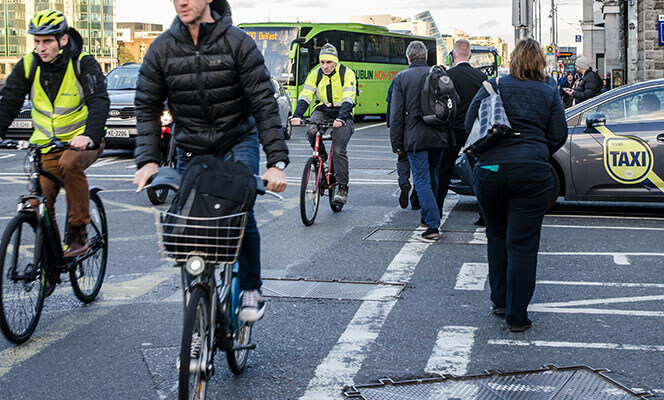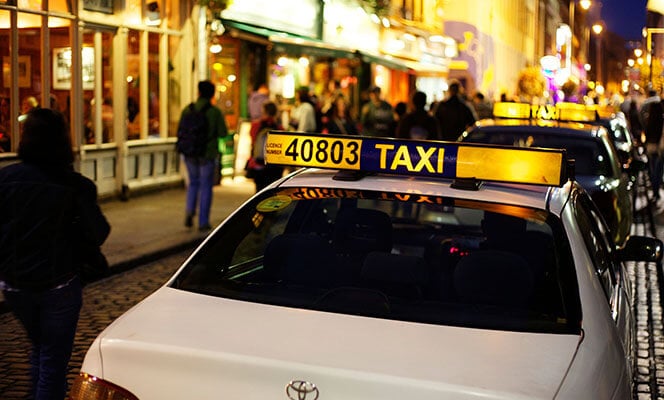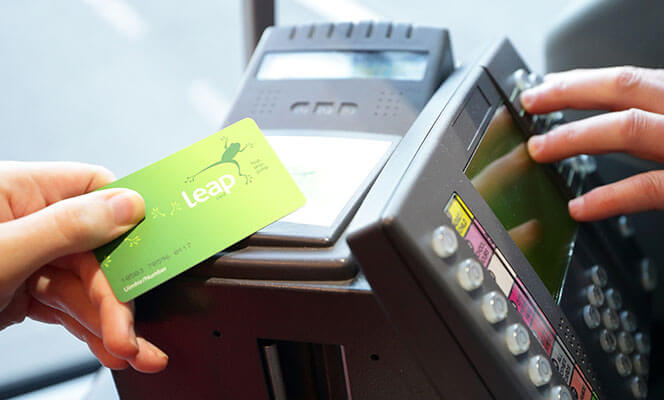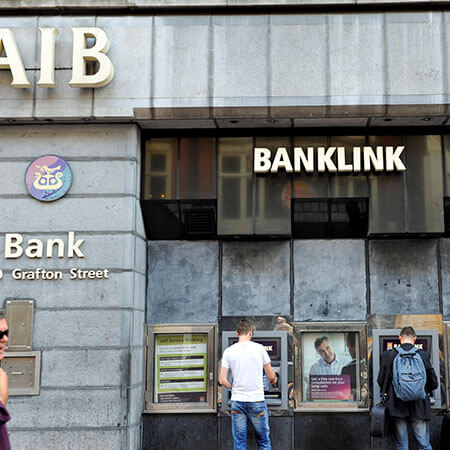Dublin is a compact and highly walkable city which is also well served by public transport. A number of the city’s colleges and universities are located right in the heart of the city centre, including Trinity College, NCAD and the Royal College of Surgeons. Others, like UCD, DCU and TU Dublin are situated in nearby suburbs.
If you plan to study in Dublin during the next college term, here’s what you need to know about getting to college – whatever institution you attend.
City centre universities and colleges
Trinity College Dublin
TCD is located in central Dublin. Its campus is serviced by a full range of public transport, including mainline railway stations, the Luas and dozens of bus routes.
National College of Art and Design
NCAD is located on Thomas Street in the Liberties area of Dublin. The 13, 40 and 123 Dublin Bus routes pass right by the front door. The St James’ Luas stop and Heuston railway station aren’t too far away either.
The Royal College of Surgeons
RCSI is located on St. Stephen’s Green – directly adjacent to the Luas stop of the same name. The college is also easily accessible by bus as well, because most routes run through the city centre. Stops for the 9, 14, 15, 16, 65, 68, 83, 122 and 140 bus routes are all just a stone’s throw away.
The Law Society of Ireland
The Law Society is located at Blackhall Place in central Dublin and is served by the 37, 39, 70 Dublin Bus routes. All of which stop right outside the door. A whole host of other buses stop just around the corner on the quays. These include all the 25 and 66 bus routes, as well as the 26, 67, 69, 79, 145 and 860.
The red line Luas is just a short walk away too. While the number 90 bus, which runs between Tara Street DART station and Heuston Station, can connect you with the city’s trainlines.
The Honorable Society of King’s Inns
King’s Inns is located between Henrietta Street and Constitution Hill in Dublin 7. The 83 bus route stops close by. But other routes that serve the area include the 11, 11d, 13d, 16, 41, 41b, 41c, 51a and 746. The Luas offers another transport option through the Broadstone stop on the green line and the Four Courts stop on the red line. Parking facilities are also available at the college.

Getting to college in the suburbs
University College Dublin
UCD’s main campus, Belfield, is located on a 132 hectare site just 4 kilometres south of Dublin city centre. The campus, which is on the R138 main road, provides its own charge point for electric cars.
Lots of Dublin Bus routes also cut through the campus, including the 7b, 7d, 25x, 27x, 32x, 39a, 41x, 47, 51x, 66x, 67x, 77x, 116, 118, 145 and 155. Another eleven routes will leave you close to the gates. So wherever you’re living, you’ll be able to get to your classes easily.
Dublin City University
DCU’s campus is located on a 60 hectare site in Glasnevin – 4 kilometres north of Dublin city centre. It’s serviced by Dublin Bus routes: 1, 4, 9, 11, 13, 16, 17a, 33, 41, 41abc, 42d and 44. It also connects with the city’s train lines and is served by other bus routes coming from outside of Dublin. You can find further details here.
TU Dublin
TU Dublin is an amalgamation of three former technological institutes which were based in Tallaght, Blanchardstown and the city centre. As a result, it has several campuses. Here’s how to get to each of the main ones.
Grangegorman
Just 1 kilometre from the city centre, this campus features Smithfield to the south, Stoneybatter to the west, Broadstone to the east and Phibsboro to the north. As a result, it is extremely accessible.
Getting to college, students can take the red line Luas to the Smithfield stop or the green line Luas to the Broadstone stop. Nearby Dublin Bus routes also include the 37, 39, 39a, 70, 46a, 4, 83, 140, 155, 83, 83a and 9.
Although, because of its proximity to the city centre, one in ten students attending the Grangegorman campus cycle. Find out more here.

Blanchardstown
TU Dublin’s Blanchardstown campus is roughly 10 kilometres northwest of the city centre and is based in Dublin 15. Because of its location in the suburbs, the campus has plenty of parking spaces which can be paid for through a semester-long permit or a pay-as-you-go ticket.
The campus is also accessible from the centre of Dublin by the 38 and 38a buses. It is also connected with a number of other Dublin suburbs through bus routes run by Go Ahead. These include the 17a, 76a, 236, 238, 239 and 270. There are also plans to connect the campus with nearby locations via a shuttle bus. You can find out more here.
Tallaght
TU Dublin’s campus in Tallaght is about 12 kilometres southwest of the city centre. It is easily accessible by bus, with the 54a, 27, 65, 75 and 175 all travelling through the city centre before stopping at the university’s entrance.
The 49, 77a, 56a, 76 and 76a all stop nearby at the Square shopping centre, as does the red line Luas. You can plan your journey here.
Maynooth University
NUI Maynooth is located in Ireland’s only university town, 25 kilometres west of Dublin city centre. Its campus is closely integrated with the town of Maynooth in county Kildare and is easily accessible by car, bus, bicycle and train.
Two Dublin Bus routes travel to the university from the city centre – the 66 and 67. Both depart from Merrion Square. You can find out more about the town’s transport connections here.
Institute of Art, Design and Technology
IADT is located in Dún Laoghaire – a scenic seaside suburb about 13 kilometres from the city centre. When getting to college, students can choose between the DART, the Luas and bus routes like the 46a, 75 and 75a. Car parking is also available at the college’s four car parks. Students can apply for parking permits here.

Out late? Here’s how to get home
‘Late’ in Dublin when it comes to transport is after 11pm. Although Dublin Bus has slowly begun to add some 24-hour bus routes to its services. Here’s what you need to know about getting around the city at night.
Dublin Bus
The last regular Dublin Bus service leaves the city centre for the suburbs around 11.30pm.
On Friday and Saturday nights, however, the Nitelink service operates approximately 20 bus routes from the city centre to the suburbs. This service begins at midnight and runs until 4am. Buses operate at regular intervals for most routes and schedules are posted on revolving notice boards at the bus stops.
You can buy a prepaid ticket at city centre shops or pay with coins on board – you won’t be given any change though. Alternatively, can use a Student Leap Card for a discounted rate. Nitelink fare is €6.60 normally or €4.50 if you’re paying with a Leap card.
Dublin Bus recently began to run three 24-hour bus routes too. They include the 15 route between Clongriffin and Tallaght; the 39a route between Ongar and UCD; and 41 route between the city centre and Swords.
The Luas, DART and train
The Luas, Dublin’s tram network, operates its last service at 00:30 Monday to Saturday and 23:30 on Sundays and public holidays. Although some city centre trams leave a little bit later. During the festive season, some services usually run late too.
Irish Rail’s DART train leaves Pearse Street station travelling north in the direction of Howth between 23:19 and 23:51. If you’re travelling south to Dun Laoghaire, the last trains leave around 23:30, depending on the day of the week. You can view all routes and schedules here.
Irish Rail also operates a commuter train service on five routes – from the city to Dundalk, Portlaoise, Longford, Dunboyne and Gorey. The final service usually leaves at around 11pm, but you’ll need to check each individual timetable here.
Taxis
The minimum taxi fare goes up to €4.20 after 8pm. That’s for the first kilometre of your journey. After that, additional kilometres are charged at €1.45 and that rate goes up €1.80 after 15 kilometres. If you’re unsure of how much a taxi will cost, you can use the taxi fare estimator to work out a ballpark figure.
You’ll find taxi ranks in the city centre on O’Connell Street and College Green, just opposite Trinity College’s main gate. Additional nighttime taxi ranks also operate between after 8pm at several locations around the city centre, including Dame Street and Merrion Row.
The queues at taxi ranks can get quite long at night, especially after the pubs and clubs close. If you don’t want to queue up, you can hail a taxi on the street. Good places to catch an empty one include the Arran Quay, Inns Quay and Ormond Quay. South of the Liffey, Camden Street, Wexford Street and South Great Georges Street are also good spots to try.
You can also opt to use a phone app like Lynk and Free Now to connect with a lift.

Want to save on travel? Get a Student Leap Card
For students getting to college via public transport, the best way to pay is with a Student Leap Card. It’s more convenient than coinage and you benefit from fare discounts of up to 50% across Dublin Bus, the DART, the Luas and commuter rail services.
Your Student Leap Card also entitles you to discounts at various shops, restaurants and entertainment venues. You can apply for one here.







